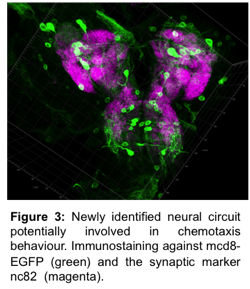 Identification of new centres participating to orientation behaviour
Identification of new centres participating to orientation behaviour
Mariana Lopez and Julia Riedl)
To map the circuits participating in larval chemotaxis, we have initiated a behavioural screen (Fig. 3). We take advantage of thousand of existing Gal4-drivers to study the effects of disabling sub-regions of the larval brain by expressing the tetanus toxin light chain (inhibitor of synaptic transmission). While specific neurons are silenced, we test the orientation capabilities of mutants to directional sensory stimuli. The anatomy and function of neuronal subsets associated with interesting phenotypes are inspected further. We use functional calcium imaging and high-resolution behavioural analysis to clarify the specific role of neurons involved in the processing of olfactory signals. In addition, remote controlled activation using specific effectors (e.g. ChR2 and TrapA1) is exploited to establish new circuit-function relationships underlying larval chemotaxis.

